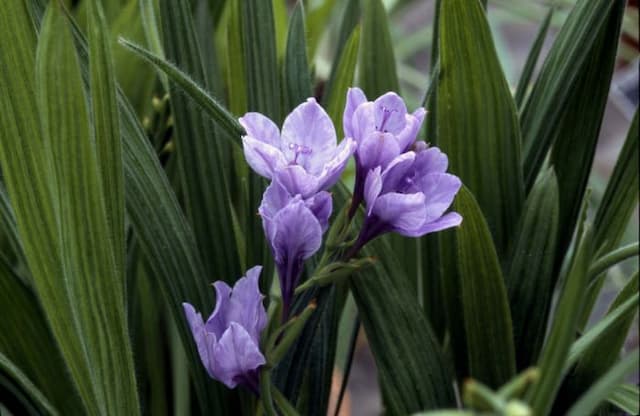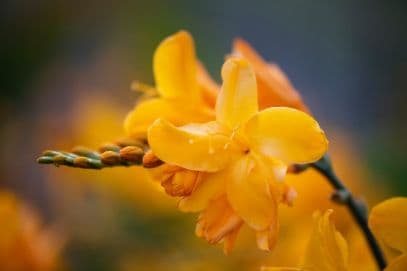Milkwhite Freesia Freesia lactea

ABOUT
The Freesia lactea is a flowering plant that is admired for its striking appearance. This plant features a delicate cluster of blooms atop slender, arching stems, which give it an airy, graceful presence. The flowers are pure white in color, which lends the plant its name, with blooms that are funnel-shaped and often display a soft, yellow throat within the heart of each flower. These blossoms are known for their lovely, sweet fragrance, which is a defining characteristic of the plant and can infuse an area with their scent. The plant's foliage consists of slender, linear leaves that are arranged in a sword-like fashion. They grow from the base of the plant, forming a tidy tuft of greenery that complements the lightness of the blossoms. Overall, the Freesia lactea strikes a balance between its vibrant green leaves and the soft white of its flowers, making it a popular choice for gardens and floral arrangements where a touch of delicate beauty is desired.
About this plant
 Names
NamesSynonyms
Milkwhite Freesia, White Freesia, White Milkmaid
Common names
Anomatheca laxa, Freesia laxa, Lapeirousia laxa.
 Toxicity
ToxicityTo humans
Freesia lactea, commonly known as just Freesia, is not commonly listed as a toxic plant to humans. However, as with many plants, individuals may experience varying levels of sensitivity or allergic reactions. If Freesia is ingested and an adverse reaction is suspected, medical attention should be sought. Symptoms could vary from mild gastrointestinal discomfort to more severe allergic reactions, depending on the individual's sensitivity.
To pets
In pets, Freesia lactea, commonly referred to as Freesia, is not typically toxic. However, some pets might be sensitive to plants that are not generally considered poisonous. If a pet ingests Freesia and exhibits symptoms such as vomiting, diarrhea, or lethargy, it is important to consult a veterinarian. While Freesia is not known for severe toxicity, individual reactions in pets can occur and may require medical attention.
 Characteristics
CharacteristicsLife cycle
Perennials
Foliage type
Deciduous
Color of leaves
Green
Flower color
White
Height
1-2 feet (30-60 cm)
Spread
1 foot (30 cm)
Plant type
Bulb
Hardiness zones
9
Native area
South Africa
Benefits
 General Benefits
General Benefits- Aesthetic Appeal: Freesia lactea, commonly known as Milk-white Freesia, has attractive white blooms that add beauty to any garden setting.
- Fragrance: The flowers of the Milk-white Freesia are known for their delightful scent, which can enhance the sensory experience of a garden or indoor space.
- Attracts Pollinators: Milk-white Freesia can attract bees, butterflies, and other beneficial pollinators, supporting the local ecosystem.
- Gift Plant: Due to its pleasing appearance and scent, it is often used as a gift in the form of cut flowers or potted plants.
- Seasonal Interest: The plant typically blooms in spring, providing visual interest during this season.
- Low Maintenance: Milk-white Freesia is considered to be a low-maintenance plant, requiring minimal care once established.
- Container Gardening: It is suitable for container gardening, making it a good option for those with limited outdoor space.
- Landscape Design: The plant can be used in various landscape designs, including borders, rock gardens, and as an underplanting for taller shrubs.
 Medical Properties
Medical PropertiesThis plant is not used for medical purposes.
 Air-purifying Qualities
Air-purifying QualitiesThis plant is not specifically known for air purifying qualities.
 Other Uses
Other Uses- Freesia lactea can be used in potpourri. The dried petals retain their fragrance and contribute a delicate scent to the mixture.
- The plant is employed in the art of ikebana, the Japanese art of flower arrangement, where its delicate structure provides an elegant touch.
- The tubers of Freesia lactea are sometimes utilized in crafting natural dyes for fabrics, offering subtle hues.
- These flowers are used in the creation of scented sachets to freshen up closets and drawers.
- Freesia plants can be a teaching tool in botany and horticulture classes to illustrate bulb growth and development.
- Essential oil derived from Freesia lactea is sometimes used in aromatherapy for its stress-relieving fragrance.
- The delicate blossoms are edible and can be used to add a colorful touch to salads or as a garnish on desserts.
- Freesia lactea is used in perfumery as a middle note, providing a peppery and milky aroma in scent compositions.
- Photographers may use the flowers as subjects to teach macro photography techniques due to their intricate details.
- In some cultures, the flowers are incorporated into wedding bouquets as a symbol of trust and innocence.
Interesting Facts
 Feng Shui
Feng ShuiThe plant Freesia is not used in Feng Shui practice.
 Zodiac Sign Compitability
Zodiac Sign CompitabilityThe plant Freesia is not used in astrology practice.
 Plant Symbolism
Plant Symbolism- Innocence: Freesia lactea often symbolizes purity and innocence due to its delicate and unblemished appearance.
- Trust: It is known to represent trust, perhaps due to the firm yet graceful support of its stem, suggesting strength and reliability in relationships.
- Lasting Friendship: The plant is associated with long-lasting friendship, making it a popular gift between friends to signify enduring support and connection.
- Thoughtfulness: As a highly fragrant flower, Freesia lactea often signifies a careful and considerate attention to detail, which is appreciated in social exchanges.
- New Beginnings: The freshness of this bloom makes it a symbol of new starts, perfect for conveying best wishes for someone embarking on a new phase of life.
 Water
WaterMilk and Wine Lily should be watered deeply to encourage the development of the roots, approximately once a week, depending on the climate and soil conditions. During active growth in spring and early summer, ensure it receives at least 1 inch of water per week, either from rainfall or manual watering. In containers, water until you see it seeping out the drainage holes, which equates to around half a gallon for a medium-sized pot. Reduce watering after the blooms have faded and the leaves begin to yellow, signaling the plant is entering dormancy.
 Light
LightMilk and Wine Lily thrives in full sun to partial shade, ideally receiving at least 6 hours of sunlight daily. The best spot for this plant is an area where it can soak up the morning sunlight while being protected from the intense heat of the afternoon, which can be achieved by situating it near taller plants or structures that provide filtered shade.
 Temperature
TemperatureMilk and Wine Lily prefers temperate environments and grows best at temperatures between 60 and 70 degrees Fahrenheit. It can withstand minimum temperatures down to around 40 degrees Fahrenheit but should be protected from frost. The maximum temperature for growth should not exceed 80 degrees Fahrenheit for extended periods to prevent heat stress.
 Pruning
PruningMilk and Wine Lily benefits from pruning to remove spent flowers and dead foliage, which encourages future blooms and maintains a tidy appearance. Prune right after flowering by cutting back the flower stalks to their base. Annual pruning at the end of the blooming season helps redirect the plant's energy to the bulbs for the next growing cycle.
 Cleaning
CleaningAs needed
 Soil
SoilMilk-White Freesia thrives best in well-draining, sandy soil enriched with organic matter, with a pH range of 6.0 to 6.5, ensuring good drainage while providing essential nutrients.
 Repotting
RepottingMilk-White Freesia bulbs should be repotted every fall before the growing season begins, ensuring a fresh environment to promote healthy growth.
 Humidity & Misting
Humidity & MistingMilk-White Freesia prefers moderate humidity levels, typically around 40-60%, to thrive without excess moisture that can lead to bulb rot.
 Suitable locations
Suitable locationsIndoor
Provide bright light, well-draining soil, and moderate humidity.
Outdoor
Plant in full sun, well-drained soil, after frost risk passes.
Hardiness zone
9-10 USDA
 Life cycle
Life cycleFreesia lactea, commonly known as Milky Freesia, begins its life cycle as a corm, which is a storage organ that helps the plant survive adverse conditions. Upon the arrival of favorable growing conditions, typically in autumn or winter, the corm sends up a shoot that develops into leaves and a flowering stalk. The plant then blooms, producing fragrant white flowers with yellow markings, which are pollinated by insects, leading to the production of seeds. After flowering, the foliage dies back, and the corm enters a dormant period during the hot and dry season, conserving energy. In the dormant phase, the original corm might also produce new cormlets, thereby propagating the plant asexually. Finally, with the return of cooler temperatures and moisture, these corms will sprout again, completing the cycle and starting a new generation of Milky Freesias.
 Propogation
PropogationPropogation time
Spring to summer
Freesia lactea, also known as Milk-and-Wine Lily, is most commonly propagated through the division of corms, which is the plant's underground storage organ similar to bulbs. The ideal time for this method is in the autumn, after the foliage has died back, signaling that the plant is entering a period of dormancy. To propagate Freesia lactea by division, carefully lift the corms from the soil after the leaves have yellowed and then remove any offsets from the main corm. These offsets can be replanted immediately or stored in a cool, dry place until planting is desired. The offsets should be planted about 2 inches deep (approximately 5 centimeters) and spaced around 3 inches apart (about 7.5 centimeters), in well-draining soil with some exposure to sunlight to encourage growth in the following season.









